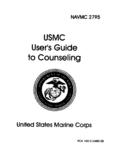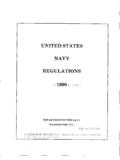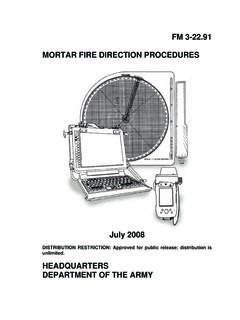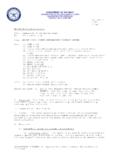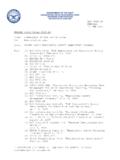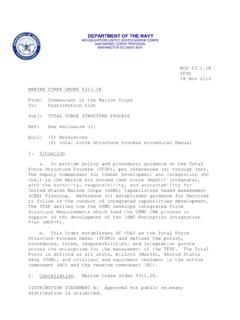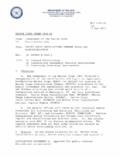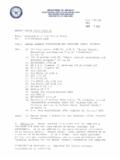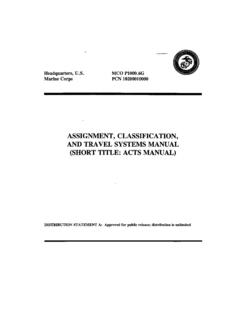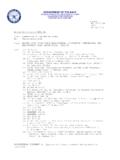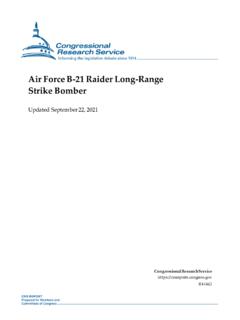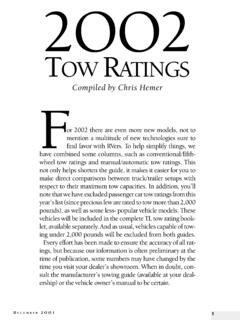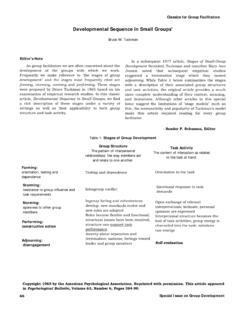Transcription of Machine Guns and Machine Gun Gunnery
1 MCWP Machine Guns and Machine Gun Gunnery Marine Corps PCN 143 000014 00 DEPARTMENT OF THE NAVYH eadquarters United States Marine CorpsWashington, 20380-00011 September 1996 Foreword1. PURPOSEM arine Corps Warfighting Publication (MCWP) , Machine Guns and Machine Gun Gun-nery, describes how various Machine guns are maintained and employed by the MarineCorps' Machine gun crews. It also provides the principles and techniques for their use in engag-ing and destroying enemy SCOPEThis reference publication is designed for Machine gunners, platoon commanders, platoon ser-geants, S-3 officers and chiefs, armorers, and ammunition technicians. It outlines a standardizedway to train Marine Machine gunners through the use of Gunnery SUPERSESSIONFMFRP 6-15, Machineguns and Machinegun Gunnery , dated 17 August CHANGESR ecommendations for improving this manual are invited from commands as well as directly fromindividuals.
2 Forward suggestions, using the User Suggestion Form format, to Commanding GeneralDoctrine Division (C 42)Marine Corps Combat Development Command3300 Russell Road Suite 318 AQuantico, Virginia 22134-50215. CERTIFICATIONR eviewed and approved this DIRECTION OF THE COMMANDANT OF THE MARINE CORPSPAUL K. VAN RIPERL ieutenant General, Marine CorpsCommanding GeneralMarine Corps Combat Development CommandQuantico, VirginiaDISTRIBUTION: 143 000014 00 Machine Guns and Machine Gun Gunnery_____iii Machine Guns and Machine Gun Gunnery_____v Machine Guns and Machine Gun Gunnery_____vii Machine Guns and Machine Gun GunneryTable of ContentsPageChapter 1. Introduction to Machine GunsChapter 2. Machine Gun, Light, Squad Automatic Weapon, M249 Section 1. Introduction .. 2-1 Section 2.
3 Disassembly and Assembly.. 2-7 Section 3. Functioning .. 2-20 Section 4. Malfunctions and Stoppages .. 2-24 Section 5. Mounts and Accessories .. 2-27 Section 6. Maintenance .. 2-29 Section 7. Ammunition .. 2-37 Section 8. Operation and Firing .. 2-40 Section 9. Qualification Firing .. 2-45 Chapter 3. Machine Gun, , M240 GSection 1. Introduction .. 3-1 Section 2. Disassembly, Assembly, and Nomenclature .. 3-7 Section 3. Functioning .. 3-19 Section 4. Malfunctions and Stoppages .. 3-23 Section 5. Mounts and Accessories .. 3-27 Section 6. Maintenance .. 3-38 Section 7. Ammunition .. 3-41 Section 8. Operation and Firing .. 3-45 Section 9. Gun Drill .. 3-50 Section 10. Qualification Firing .. 3-56 Section 11. Firing with Blank Ammunition .. 3-62 Chapter 4. Machine Gun, Caliber.
4 50, Browning, M2 HBSection 1. Introduction .. 4-1 Section 2. Disassembly, Assembly, and Nomenclature .. 4-7 Section 3. Headspace and Timing .. 4-26 Section 4. Functioning .. 4-29 Section 5. Malfunctions and Stoppages .. 4-35 Section 6. Mounts and Accessories .. 4-39 Section 7. Maintenance .. 4-43 Section 8. Ammunition .. 4-47 Section 9. Operation and Firing .. 4-53 Section 10. Gun Drill .. 4-56 Section 11. Qualification Firing .. 4-64viii _____ MCWP 5. Machine Gun, 40mm, MK-19 MOD 3 Section 1. Introduction ..5-1 Section 2. Disassembly, Assembly, and Nomenclature ..5-7 Section 3. Functioning ..5-15 Section 4. Malfunctions and Stoppages ..5-20 Section 5. Mounts and Accessories ..5-22 Section 6. Maintenance..5-30 Section 7. Ammunition ..5-32 Section 8. Operation and Firing.
5 5-36 Section 9. Gun Drill ..5-40 Chapter 6. Employment and GunnerySection 1. Introduction ..6-1 Section 2. Characteristics of Fire ..6-9 Section 3. Classes of Fire ..6-12 Section 4. Range Determination ..6-16 Section 5. Traversing and Elevating Mechanism ..6-18 Section 6. Fire Control ..6-21 Section 7. Methods of Target Engagement..6-25 Section 8. Overhead Fires..6-36 Section 9. Techniques of Predetermined Fire..6-42 Section 10. Final Protective Lines ..6-46 Section 11. Range Cards..6-49 Section 12. Firing From Defilade Position ..6-53 Section 13. Machine Gunner s Mathematics ..6-60 Section 14. Antiaircraft Gunnery ..6-64 Section 15. Firing Positions ..6-72 Section 16. Wire Communications ..6-75 AppendicesAppendix A. M60E3/M240G Firing Tables..A-1 Appendix B. M2 .50 Cal Firing Tables.
6 B-1 Appendix C. MK-19 MOD 3 Firing Tables ..C-1 Appendix D. Destruction of Machine Guns ..D-1 Appendix E. Infantry Plotting Board M17 ..E-1 Appendix F. Adjustment of Indirect Machine Gun Fire..F-1 Appendix G. Final Protective Lines ..G-1 Appendix H. Acronyms and Abbreviations ..H-1 Appendix I. References and Related Publications ..I-1 NotesChapter 1 INTRODUCTION TO Machine GUNS For their part the Machine -gun units must be on the alert to seize and exploit every opportu-nity to assist the forward movement of the rifle units, without waiting for specific orders to en-gage a particular targe or locality. FMFRP 12-2, Infantry In Battle1 Leaders must know what the guns can do before the attack starts, what they can do while theattack is in progress, and what they can do during reorganization and consolidation.
7 Theymust learn to seek and to recognize opportunities for employing Machine guns in every phaseof the action. Finally, they must have the aggressiveness to keep everlastingly at the task ofgetting the guns forward, so that when opportunity does present, they will be able to seize it. FMFRP 12-2, Infantry In Battle2 Desert Storm, KuwaitA Marine Machine Gunner Scans the Desert For Targets1-2 _____ MCWP of Contents1001 History1002 Types of Machine Guns1003 Machine Gun Employment1004 Principles of Machine Gun EmploymentList of Figures1-1 Marine Automatic Rifleman, Operation Desert Shield1-2 Marines From the Enlisted InstructorCompany Train New Lieutenants in the Field, The Basic School, Quantico, Virginia1-3 Heavy Machine Gun Squad in TrainingDuring Operation Desert ShieldChapter 1 Introduction to Machine Guns1001.
8 HistoryDespite their post-Civil War development, modernmachine guns didn t begin to exhibit their full potentialin battle until World War I. The effects on employ-ment of these new weapons systems altered the doctri-nal way of waging war for both Allied and Axispowers. Properly employed Machine guns proved to bedevastating to massed infantry formations and pavedthe way for the creation of a whole new methodologyof warfighting. The Machine gun became the keystoneof the infantry defense and a major supplier of organicfirepower in the offense. New tactics were being devel-oped by both sides to not only exploit the effects of themachine gun, but to counter the enemy s Machine gunemployment capabilities. The Machine gun changed the face of modern warfarejust as surely as the development of aircraft and preci-sion indirect fire artillery.
9 The impact of this weaponcan be seen not only in military writings of thatperiod, but in the principles of employment still in usetoday. FMFRP 12-2, Infantry in Battle, a compilationof lessons learned from World War I, provides awealth of knowledge concerning the employment ofmachine guns. These lessons remain applicable andare still studied today, almost 70 years later. Theproper employment of Machine guns has won many abattle at the company and platoon level, and a wellrehearsed, proficient Machine gun team can some-times make the difference between success and fail-ure on the battlefield. Military history is filled withexamples of the impact that Machine guns and theirgunners have had in turning the tide of battle: Machine guns affect the outcome of battle byfire power alone.
10 Guns that have not fired have notattacked, no matter how many times they have beenplaced in position. 3 The Machine gun acts by fire alone; move-ment of this weapon has no other purpose than tosecure positions from which more effective fire can bedelivered. Maximum usefulness is obtained only whenevery gun within range of the enemy is firing effec-tively against him. 4 Although Machine guns lend themselvesmore readily to the defense than to the attack, this isno excuse for a failure to exact the utmost from themin support of advancing troops. The handicaps totheir effective employment in the attack can be andmust be overcome. 5 Though the weapons themselves have changed overthe years and will continue to do so, the basic consid-erations for their employment remain constant.
